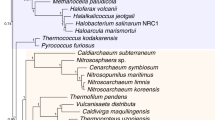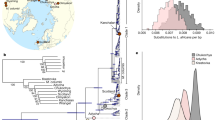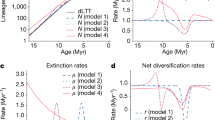Abstract
High-throughput sequencing projects generate genome-scale sequence data for species-level phylogenies1,2,3. However, state-of-the-art Bayesian methods for inferring timetrees are computationally limited to small datasets and cannot exploit the growing number of available genomes4. In the case of mammals, molecular-clock analyses of limited datasets have produced conflicting estimates of clade ages with large uncertainties5,6, and thus the timescale of placental mammal evolution remains contentious7,8,9,10. Here we develop a Bayesian molecular-clock dating approach to estimate a timetree of 4,705 mammal species integrating information from 72 mammal genomes. We show that increasingly larger phylogenomic datasets produce diversification time estimates with progressively smaller uncertainties, facilitating precise tests of macroevolutionary hypotheses. For example, we confidently reject an explosive model of placental mammal origination in the Palaeogene8 and show that crown Placentalia originated in the Late Cretaceous with unambiguous ordinal diversification in the Palaeocene/Eocene. Our Bayesian methodology facilitates analysis of complete genomes and thousands of species within an integrated framework, making it possible to address hitherto intractable research questions on species diversifications. This approach can be used to address other contentious cases of animal and plant diversifications that require analysis of species-level phylogenomic datasets.
This is a preview of subscription content, access via your institution
Access options
Access Nature and 54 other Nature Portfolio journals
Get Nature+, our best-value online-access subscription
$29.99 / 30 days
cancel any time
Subscribe to this journal
Receive 51 print issues and online access
$199.00 per year
only $3.90 per issue
Buy this article
- Purchase on Springer Link
- Instant access to full article PDF
Prices may be subject to local taxes which are calculated during checkout



Similar content being viewed by others
Data availability
All data required to reproduce the analyses are available at https://doi.org/10.6084/m9.figshare.14885691.
Code availability
A repository containing instructions to reproduce the analyses is available at http://github.com/sabifo4/mammals_dating and https://doi.org/10.5281/zenodo.5736629. The MCMCtree software and mcmc3r R package are freely available from http://abacus.gene.ucl.ac.uk/software/paml.html and https://github.com/dosreislab, respectively.
References
Zoonomia Consortium. A comparative genomics multitool for scientific discovery and conservation. Nature 587, 240–245 (2020).
Feng, S. et al. Dense sampling of bird diversity increases power of comparative genomics. Nature 587, 252–257 (2020).
Harvey, M. G. et al. The evolution of a tropical biodiversity hotspot. Science 370, 1343–1348 (2020).
dos Reis, M., Donoghue, P. C. J. & Yang, Z. Bayesian molecular clock dating of species divergences in the genomics era. Nat. Rev. Genet. 17, 71–80 (2016).
Meredith, R. W. et al. Impacts of the Cretaceous Terrestrial Revolution and KPg extinction on mammal diversification. Science 334, 521–524 (2011).
Upham, N. S., Esselstyn, J. A. & Jetz, W. Inferring the mammal tree: species-level sets of phylogenies for questions in ecology, evolution, and conservation. PLoS Biol. 17, e3000494 (2019).
dos Reis, M. et al. Phylogenomic datasets provide both precision and accuracy in estimating the timescale of placental mammal phylogeny. Proc. Biol. Sci. 279, 3491–3500 (2012).
O’Leary, M. A. et al. The placental mammal ancestor and the post-K-Pg radiation of placentals. Science 339, 662–667 (2013).
dos Reis, M., Donoghue, P. C. & Yang, Z. Neither phylogenomic nor palaeontological data support a Palaeogene origin of placental mammals. Biol. Lett. 10, 20131003 (2014).
Phillips, M. J. Geomolecular dating and the origin of placental mammals. Syst. Biol. 65, 546–557 (2016).
Lewin, H. A. et al. Earth BioGenome Project: sequencing life for the future of life. Proc. Natl Acad. Sci. USA 115, 4325–4333 (2018).
Siepel, A. Challenges in funding and developing genomic software: roots and remedies. Genome Biol. 20, 147 (2019).
Faria, N. R. et al. The early spread and epidemic ignition of HIV-1 in human populations. Science 346, 56–61 (2014).
Ramírez-Barahona, S., Sauquet, H. & Magallón, S. The delayed and geographically heterogeneous diversification of flowering plant families. Nat. Ecol. Evol. 4, 1232–1238 (2020).
Whelan, N. V. et al. Ctenophore relationships and their placement as the sister group to all other animals. Nat. Ecol. Evol. 1, 1737–1746 (2017).
Misof, B. et al. Phylogenomics resolves the timing and pattern of insect evolution. Science 346, 763–767 (2014).
Jarvis, E. D. et al. Whole-genome analyses resolve early branches in the tree of life of modern birds. Science 346, 1320–1331 (2014).
Tao, Q., Tamura, K. & Kumar, S. in The Molecular Evolutionary Clock: Theory and Practice (ed. Ho, S. Y. W.) 197–219 (Springer, 2020).
Thorne, J. L. & Kishino, H. in Statistical Methods in Molecular Evolution (ed. Nielsen, R.) 235–256 (Springer, 2005).
Yang, Z. & Rannala, B. Bayesian estimation of species divergence times under a molecular clock using multiple fossil calibrations with soft bounds. Mol. Biol. Evol. 23, 212–226 (2006).
Inoue, J., Donoghue, P. C. J. & Yang, Z. The impact of the representation of fossil calibrations on Bayesian estimation of species divergence times. Syst. Biol. 59, 74–89 (2010).
dos Reis, M., Zhu, T. & Yang, Z. The impact of the rate prior on Bayesian estimation of divergence times with multiple Loci. Syst. Biol. 63, 555–565 (2014).
Rannala, B. & Yang, Z. Inferring speciation times under an episodic molecular clock. Syst. Biol. 56, 453–466 (2007).
Springer, M. S., Murphy, W. J., Eizirik, E. & O’Brien, S. J. Placental mammal diversification and the Cretaceous–Tertiary boundary. Proc. Natl Acad. Sci. USA 100, 1056–1061 (2003).
Hasegawa, M., Thorne, J. L. & Kishino, H. Time scale of eutherian evolution estimated without assuming a constant rate of molecular evolution. Genes Genet. Syst. 78, 267–283 (2003).
Alroy, J. The fossil record of North American mammals: evidence for a Paleocene evolutionary radiation. Syst. Biol. 48, 107–118 (1999).
Benton, M. J. Early origins of modern birds and mammals: Molecules vs. morphology. Bioessays 21, 1043–1051 (1999).
Hunter, J. P. & Janis, C. M. Spiny Norman in the Garden of Eden? Dispersal and early biogeography of Placentalia. J. Mamm. Evol. 13, 89–123 (2006).
Luo, Z. X. Transformation and diversification in early mammal evolution. Nature 450, 1011–1019 (2007).
Cooper, A. & Fortey, R. Evolutionary explosions and the phylogenetic fuse. Trends Ecol. Evol. 13, 151–156 (1998).
Archibald, J. D. & Deutschman, D. H. Quantitative analysis of the timing of the origin and diversification of extant placental orders. J. Mamm. Evol. 8, 107–124 (2001).
Murphy, W. J., Foley, N. M., Bredemeyer, K. R., Gatesy, J. & Springer, M. S. Phylogenomics and the genetic architecture of the placental mammal radiation. Annu. Rev. Anim. Biosci. 9, 29–53 (2021).
Tarver, J. E. et al. The interrelationships of placental mammals and the limits of phylogenetic inference. Genome Biol. Evol. 8, 330–344 (2016).
Liu, L. et al. Genomic evidence reveals a radiation of placental mammals uninterrupted by the KPg boundary. Proc. Natl Acad. Sci. USA 114, E7282–E7290 (2017).
dos Reis, M. et al. Using phylogenomic data to explore the effects of relaxed clocks and calibration strategies on divergence time estimation: primates as a test case. Syst. Biol. 67, 594–615 (2018).
dos Reis, M. & Yang, Z. The unbearable uncertainty of Bayesian divergence time estimation. J. Syst. Evol. 51, 30–43 (2013).
dos Reis, M. & Yang, Z. Approximate likelihood calculation on a phylogeny for Bayesian estimation of divergence times. Mol. Biol. Evol. 28, 2161–2172 (2011).
Battistuzzi, F. U., Billing-Ross, P., Paliwal, A. & Kumar, S. Fast and slow implementations of relaxed-clock methods show similar patterns of accuracy in estimating divergence times. Mol. Biol. Evol. 28, 2439–2442 (2011).
Donoghue, P. C. J. & Yang, Z. The evolution of methods for establishing evolutionary timescales. Philos. Trans. R. Soc. Lond. B 371, 20160020 (2016).
Xie, W., Lewis, P. O., Fan, Y., Kuo, L. & Chen, M.-H. Improving marginal likelihood estimation for Bayesian phylogenetic model selection. Syst. Biol. 60, 150–160 (2011).
Thorne, J. L., Kishino, H. & Painter, I. S. Estimating the rate of evolution of the rate of molecular evolution. Mol. Biol. Evol. 15, 1647–1657 (1998).
Drummond, A. J., Ho, S. Y. W., Phillips, M. J. & Rambaut, A. Relaxed phylogenetics and dating with confidence. PLoS Biol. 4, 699–710 (2006).
Politis, D. N. & Romano, J. P. The stationary bootstrap. J. Am. Stat. Assoc. 89, 1303–1313 (1994).
Nishihara, H., Maruyama, S. & Okada, N. Retroposon analysis and recent geological data suggest near-simultaneous divergence of the three superorders of mammals. Proc. Natl Acad. Sci. USA 106, 5235–5240 (2009).
Wheeler, T. J. & Eddy, S. R. nhmmer: DNA homology search with profile HMMs. Bioinformatics 29, 2487–2489 (2013).
Bininda-Emonds, O. R. et al. The delayed rise of present-day mammals. Nature 446, 507–512 (2007).
Louca, S. & Pennell, M. W. Extant timetrees are consistent with a myriad of diversification histories. Nature 580, 502–505 (2020).
Zwart, S. P. The ecological impact of high-performance computing in astrophysics. Nat. Astron. 4, 819–822 (2020).
Springer, M. S., Stanhope, M. J., Madsen, O. & de Jong, W. W. Molecules consolidate the placental mammal tree. Trends Ecol. Evol. 19, 430–438 (2004).
Kinsella, R. J. et al. Ensembl BioMarts: a hub for data retrieval across taxonomic space. Database 2011, bar030 (2011).
Löytynoja, A. Phylogeny-aware alignment with PRANK. Methods Mol. Biol. 1079, 155–170 (2014).
Stamatakis, A. RAxML version 8: a tool for phylogenetic analysis and post-analysis of large phylogenies. Bioinformatics 30, 1312–1313 (2014).
Springer, M. S. & Gatesy, J. On the importance of homology in the age of phylogenomics. Syst. Biodivers. 16, 210–228 (2018).
Paradis, E., Claude, J. & Strimmer, K. APE: analyses of phylogenetics and evolution in R language. Bioinformatics 20, 289–290 (2004).
dos Reis, M. et al. Uncertainty in the timing of origin of animals and the limits of precision in molecular timescales. Curr. Biol. 25, 2939–2950 (2015).
Eddy, S. R. Profile hidden Markov models. Bioinformatics 14, 755–763 (1998).
Löytynoja, A., Vilella, A. J. & Goldman, N. Accurate extension of multiple sequence alignments using a phylogeny-aware graph algorithm. Bioinformatics 28, 1684–1691 (2012).
Mitchell, K. J. et al. Molecular phylogeny, biogeography, and habitat preference evolution of marsupials. Mol. Biol. Evol. 31, 2322–2330 (2014).
Yang, Z. PAML 4: phylogenetic analysis by maximum likelihood. Mol. Biol. Evol. 24, 1586–1591 (2007).
Hasegawa, M., Kishino, H. & Yano, T. Dating of the human-ape splitting by a molecular clock of mitochondrial DNA. J. Mol. Evol. 22, 160–174 (1985).
Hasegawa, M., Yano, T.-A. & Kishino, H. A new molecular clock of mitochondrial DNA and the evolution of hominoids. Proc. Japan Acad. B 60, 95–98 (1984).
Yang, Z. Maximum likelihood phylogenetic estimation from DNA sequences with variable rates over sites: approximate methods. J. Mol. Evol. 39, 306–314 (1994).
Felsenstein, J. Evolutionary trees from DNA sequences: a maximum likelihood approach. J. Mol. Evol. 17, 368–376 (1981).
dos Reis, M. & Yang, Z. in Evolutionary Genomics: Statistical and Computational Methods (ed. Anisimova, M.) 309–330 (Springer, 2019).
Rannala, B., Zhu, T. & Yang, Z. Tail paradox, partial identifiability, and influential priors in Bayesian branch length inference. Mol Biol Evol. 29, 325–335 (2012).
Benton, M. J. et al. Constraints on the timescale of animal evolutionary history. Palaeontol. Electron. 18, 1–106 (2015).
Parham, J. F. et al. Best practices for justifying fossil calibrations. Syst. Biol. 61, 346–359 (2012).
Warnock, R. C. M., Parham, J. F., Joyce, W. G., Lyson, T. R. & Donoghue, P. C. J. Calibration uncertainty in molecular dating analyses: there is no substitute for the prior evaluation of time priors. Proc. R. Soc. B 282, 20141013 (2015).
Rambaut, A., Drummond, A. J., Xie, D., Baele, G. & Suchard, M. A. Posterior summarization in Bayesian phylogenetics using Tracer 1.7. Syst. Biol. 67, 901–904 (2018).
Plummer, M., Best, N., Cowles, K. & Vines, K. CODA: convergence diagnosis and output analysis for MCMC. R News 6, 7–11 (2006).
RStan: the R interface to Stan. R package. https://mc-stan.org (Stan Development Team, 2020).
Puttick, M. N. MCMCtreeR: functions to prepare MCMCtree analyses and visualize posterior ages on trees. Bioinformatics 35, 5321–5322 (2019).
Azzalini, A. The R package ‘sn’: the skew-normal and related distributions such as the skew-t. http://azzalini.stat.unipd.it/SN/ (2019).
Acknowledgements
We thank J. Gilbert and C. G. Faulkes for help with the Rodentia subtrees. This work used computing resources from Queen Mary’s Apocrita HPC and University College London Myriad HPC facilities. This work was supported by Biotechnology and Biological Sciences Research Council, UK, awards BB/T01282X/1, BB/T012951/1 and BB/T012773/1.
Author information
Authors and Affiliations
Contributions
M.d.R. conceived the work. M.d.R., Z.Y., P.C.J.D., S.Á.-C. and A.U.T. designed the analysis. S.Á.-C., A.U.T., R.J.A., P.C.J.D., M.B., E.C. and F.F.N. compiled, processed and verified the molecular and fossil data. S.Á.-C., A.U.T. and M.d.R. analysed the data. M.d.R. and P.C.J.D. wrote the paper with input from all authors.
Corresponding authors
Ethics declarations
Competing interests
The authors declare no competing interests.
Peer review information
Nature thanks Olaf Bininda-Emonds, Xing-Xing Shen and the other, anonymous reviewers for their contribution to the peer review of this work.
Additional information
Publisher’s note Springer Nature remains neutral with regard to jurisdictional claims in published maps and institutional affiliations.
Extended data figures and tables
Extended Data Fig. 1 Comparison of prior and posterior times.
a, Prior distribution of node ages generated by MCMC sampling without the molecular alignment. b, Posterior distribution of node ages when the 72-genome alignment is included during MCMC sampling. In both a and b, nodes are plotted at their posterior mean ages. The blue horizontal bars indicate the 95% credibility intervals of node ages.
Extended Data Fig. 2 Impact of fossil calibration strategies on node age estimates.
The posterior of node ages for the 72-taxon phylogeny is estimated using two additional fossil calibration strategies (y-axis) and plotted against the main estimates using best practice in calibration choice39 (x-axis). In all cases the fossil minima are the same, but the calibration maxima changes. In the first strategy (black dots), calibration densities are narrow and close to the fossil ages. A truncated-Cauchy with a short tail (using p = 0 and c = 0.001, which extends the tail to about 110% of the fossil age) is used21. This strategy assumes the fossil record is a good indicator of the true node ages. In the second strategy (red dots), a truncated-Cauchy with a heavy tail (using p = 0.1 and c = 1, which extends the tail to over 900% of the fossil age) is used21. This strategy ignores the presence and absence of stem and sister groups, their palaeoecology, palaeobiogeography, and comparative taphonomy39; and instead, assumes the node ages can be arbitrarily old. Dots are plotted at the posterior mean ages and vertical and horizontal bars indicate 95% CIs. The solid line is the x = y line. The dashed lines are the regression lines for the corresponding data points.
Supplementary information
Supplementary Information
This file contains Supplementary Information, including Supplementary Figs. 1–11, Tables 1–13, annex and additional references.
Rights and permissions
About this article
Cite this article
Álvarez-Carretero, S., Tamuri, A.U., Battini, M. et al. A species-level timeline of mammal evolution integrating phylogenomic data. Nature 602, 263–267 (2022). https://doi.org/10.1038/s41586-021-04341-1
Received:
Accepted:
Published:
Issue Date:
DOI: https://doi.org/10.1038/s41586-021-04341-1
This article is cited by
-
Animal models to study cardiac regeneration
Nature Reviews Cardiology (2024)
-
Palaeoatmosphere facilitates a gliding transition to powered flight in the Eocene bat, Onychonycteris finneyi
Communications Biology (2024)
-
Hagfish genome elucidates vertebrate whole-genome duplication events and their evolutionary consequences
Nature Ecology & Evolution (2024)
-
The evolution of human altriciality and brain development in comparative context
Nature Ecology & Evolution (2023)
-
A probable koala from the Oligocene of central Australia provides insights into early diprotodontian evolution
Scientific Reports (2023)
Comments
By submitting a comment you agree to abide by our Terms and Community Guidelines. If you find something abusive or that does not comply with our terms or guidelines please flag it as inappropriate.



